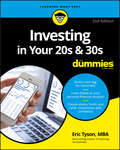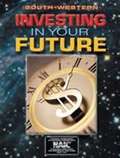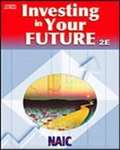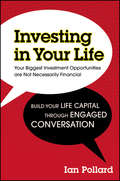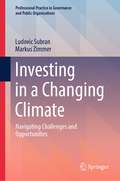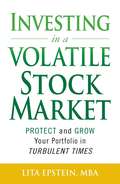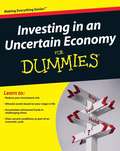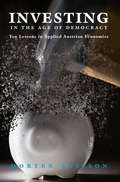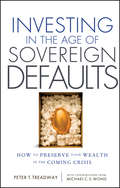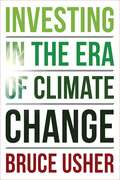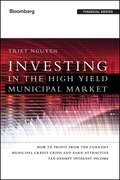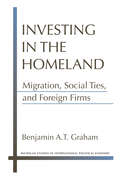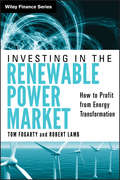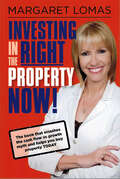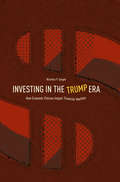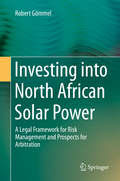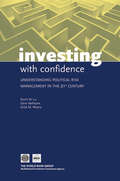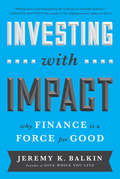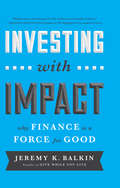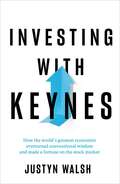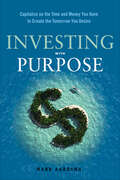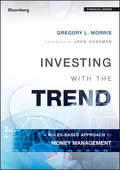- Table View
- List View
Investing in Your 20s and 30s For Dummies
by Eric Tyson<p>In order to build a retirement portfolio that is capable of covering expenses in your golden years, it's necessary to start saving while you're young. Many individuals realize the importance of investing early in life, but simply don't know where to begin. <p><i>Investing in Your 20s & 30s For Dummies</i> provides emerging professionals, like yourself, with the targeted investment advice that you need to establish your own unique investment style. Covering everything from the latest tax laws to new and improved investing funds, this latest edition helps you evaluate assets and manage risk to invest money wisely, and monitor your progress. <p> <li>Start building a nest egg for retirement <li>Invest based on your own financial situation <li>Understand investment lingo <li>Have the confidence to manage your money for life <li>Determine your investment timeline and goals</li> <p> <p>There's no time like the present to start investing. So, get started today!</p>
Investing in Your Child's Future: Financial Planning for Your Child's Education
by Nicola FieldMost parents dream of giving their children the best possible education. However an education – primary, secondary and tertiary – costs money. Parents of a child born in 2006 can pay approximately $250K for a child's lifetime education according to the latest research from the Australian Scholarships Group. And costs are constantly on the rise. Investing in Your Child's Future is aimed at parents and future parents, grandparents and other family members, and covers children's education from pre-school to tertiary studies. It is designed to show readers how they can secure and contribute to their children's future and can benefit from a higher education at the institution of their choice, without sacrificing their lifestyle or financial security, and regardless of their income. Investing in Your Child's Future shows readers how they can finance all, or some, of their children's education by planning ahead, implementing simple strategies and saving money as early and as regularly as possible. When your children are young, it's easy to delay funding their education as it is not an immediate expense. However, education is a major expense, regardless of whether you choose a private or public education, and the sooner you start saving, the more money you will accumulate, and the sooner you can stop worrying about your child's future.
Investing in Your Future
by National Association of Investers Corporation StaffInvesting in Your Future leads the user step-by-step into the fascinating world of financial planning and investing.
Investing in Your Future
by National Association of Investors CorporationThis practical and accessible guide explains the benefits of long-term investment, illustrates how to evaluate mutual funds and corporations, and walks through the stock selection guide developed by BetterInvesting. The worksheets and career advice suggest the book could also be used in community college courses. The second edition devotes an entire chapter to stock selection. Annotation ©2007 Book News, Inc., Portland, OR (booknews.com)
Investing in Your Life: Your Biggest Investment Opportunities are Not Necessarily Financial
by Ian PollardThe great investors of our time have taught us many lessons about generating enormous wealth through investment; but what if we could use those principles to realize our full potential -- not only financially, but in our relationships, education and careers? In this book, businessman and executive coach Dr Ian Pollard will take you on a thought-provoking journey that will encourage you to view your conversations, relationships, opportunities and decisions in a whole new light. Pollard's multi-disciplinary approach will help you discover how to: improve your conversation and decision-making skills understand and manage your strengths and weaknesses build relationships and expand your networks change negative behaviour patterns learn from success and failure make uncertainty work better for you achieve a better work/life balance. By inspiring you to view your own development through the eyes of an investor, Investing in Your Life will help you appreciate the size of the opportunities available to you. This book will empower you to maximise your potential by actively investing in the best opportunities, and will make your life more meaningful, satisfying and rewarding.
Investing in a Changing Climate: Navigating Challenges and Opportunities (Professional Practice in Governance and Public Organizations)
by Ludovic Subran Markus ZimmerNet Zero is not enough. We have dithered so long about climate change that, by now, we would need to go to negative-emissions territory, well before 2050, to keep global warming under the iconic 1.5°C target. The national commitments made so far fall short of what is needed, and so do the investments envisioned. But even with the best of intentions, it is hard for policymakers and potential investors to discern where, in the profusion of initiatives and technologies, it would make sense to focus their attention and resources. This is where this book comes in. It offers a clear-eyed view of how far along the decarbonization path six key sectors of the economy are—namely energy, utilities, transportation, industry, buildings, and agriculture—and which areas and technologies within each sector are promising in terms of investments to advance the cause. Furthermore, a special chapter on Africa spotlights a continent that is simultaneously one of the worst affected by climate change, the most likely to see its greenhouse gas emissions increase—and the one with the greatest potential for solving the West's, and the world’s, energy transition and economic growth conundrum. As such, the book serves as a concise guide both to the state of the battle against global warming, and for investors, professionals, and policymakers to find their way through the maze of options.
Investing in a Volatile Stock Market
by Lita EpsteinProtect and Grow Your Portfolio in Turbulent Times
Investing in a Volatile Stock Market
by Lita EpsteinUnsinkable Stocks provides readers with detailed strategies on how to best protect and increase their investment portfolio against the vagaries of turbulent markets and economies. It includes information about the equities, bonds, fund, commodities, real estate, and other investment opportunities and how to organize them into a cogent plan to keep solvent and prosper in today's unpredictable market.
Investing in a Volatile Stock Market: How to Use Everything from Gold to Daytrading to Ride Out Today's Turbulent Markets
by Lita EpsteinUnsinkable Stocks provides readers with detailed strategies on how to best protect and increase their investment portfolio against the vagaries of turbulent markets and economies. It includes information about the equities, bonds, fund, commodities, real estate, and other investment opportunities and how to organize them into a cogent plan to keep solvent and prosper in today’s unpredictable market.
Investing in an Uncertain Economy for Dummies
by Sheryl GarrettInvesting in an Uncertain Economy For Dummies provides investors with focused, individualized investment strategies that enable them to conquer indecision and protect and strengthen their current financial holdings. With advice from 200 top independent financial advisers, empowered readers can make effective asset allocation decisions in the face of volatile markets.
Investing in the Age of Democracy: Ten Lessons In Applied Austrian Economics
by Morten ArissonThis book offers a structured, deductive approach to Austrian investing, beginning with an analysis of the current investing paradigm. There are five economic concepts on which the Austrian School of Economics has a unique view: Entrepreneurship, Class Probability, Capital, the Interest Rate, and Institutions. This book explains, lesson by lesson, how each of theseshapes our thinking about investing. If we follow them through their logical consequences, they leave us with a unique approach to investing. Except for the theory of probability, there has not been a comprehensive analysis of the linkages between these concepts, when it comes to investing. Although they would have been obvious to the average investor before the age of democracy, since the French and American revolutions, government interventions have steadily transformed the way we think about them (and the way we invest). Above all, Entrepreneurship and Institutions are downplayed today, while investors use Case Probability, and confuse the concepts of Money and Capital.This book offers a historical review of these interventions, to shed light on how we went from what was common sense to the status quo. Offering a sometimes technical analysis, the book examines a series of fundamental investment fallacies, their origins and how not to fall for them.
Investing in the Age of Sovereign Defaults
by Michael C. S. Wong Peter T. TreadwayAcclaimed investment experts Peter Treadway and Michael Wong explain how to protect your investments--and even profit--from the coming sovereign default crises A major sovereign default crisis is looming for the so-called developed economies of the world. The result will be a major redistribution of economic wealth and an overhaul of the international financial system on an epic scale. Investing in the Age of Sovereign Defaults: How to Preserve your Wealth in the Coming Crisis explains what lies ahead, and offers invaluable suggestions to help investors avoid massive losses. Explains why the West is headed for a major default crisis and how investors can protect themselves Contends that the value of gold will continue to rise and that sooner or later government debt, including that of the U. S. and Japan, will be shunned Written by investment experts Peter Treadway and Michael Wong The days of the economic status quo are coming to an end. Investing in the Age of Sovereign Defaults shows investors what's coming and what investors must do if they want to escape unscathed.
Investing in the Era of Climate Change
by Professor Bruce UsherA climate catastrophe can be avoided, but only with a rapid and sustained investment in companies and projects that reduce greenhouse gas emissions. To the surprise of many, this has already begun. Investors are abandoning fossil-fuel companies and other polluting industries and financing businesses offering climate solutions. Rising risks, evolving social norms, government policies, and technological innovation are all accelerating this movement of capital.Bruce Usher offers an indispensable guide to the risks and opportunities for investors as the world faces climate change. He explores the role that investment plays in reducing emissions to net zero by 2050, detailing how to finance the winners and avoid the losers in a transforming global economy. Usher argues that careful examination of climate solutions will offer investors a new and necessary lens on the future for their own financial benefit and for the greater good. Companies that reduce greenhouse gas emissions will create great wealth, and, more importantly, they will provide a lifeline for humanity.Grounded in academic and industry research, Usher’s insights bring clarity to a complex and controversial topic while illuminating the people behind the numbers. This book sets out a practical and actionable plan for investors that will alter the course of climate change.
Investing in the High Yield Municipal Market
by Triet NguyenA practical guide to profiting from the high yield municipal marketThis unique guide to the high yield municipal bond market sheds some much-needed light on this esoteric but profitable corner of the fixed-income world. It fills the void between the general reference handbooks on municipal bonds and the superficial treatment of do-it-yourself bond guides, with an emphasis on practical trading applications.Having witnessed the beginning of the modern high yield tax-exempt institutional market, author Triet Nguyen documents its historical evolution, outlines a conceptual framework for high yield tax-free investing, one that takes into account both interest rate and credit cycles, and reviews the latest historical data on municipal defaults, including for the first time the non-rated sector. Current distressed opportunities are also discussed. Along the way, Nguyen takes the time to discuss in detail the pros and cons of investing in pre-packaged high yield vehicles--from mutual funds to hedge funds to exchange-traded funds--with frank and objective insider tips on how these slickly marketed products really work. For the truly committed investor who wants to do his or her own homework, Nguyen and a group of industry experts go over the key investment considerations for several major classes of high yield tax-exempt bonds.Offers unique insights into the risk/return, trading, and liquidity characteristics of high yield municipal instrumentsIncludes interesting case studies to fully illustrate the high yield investing processWritten by an insider of both the asset management industry and the broker-dealer communityInvesting in the High Yield Municipal Market will put you in a better position to profit in this arena and help you excel in today's tough financial environment.
Investing in the Homeland: Migration, Social Ties, and Foreign Firms (Michigan Studies In International Political Economy)
by Benjamin A.T. GrahamOnce viewed as a “brain drain,” migrants are increasingly viewed as a resource for promoting economic development back in their home countries. In Investing in the Homeland, Benjamin Graham finds that diasporans—migrants and their descendants—play a critical role in linking foreign firms to social networks in developing countries, allowing firms to flourish even in challenging political environments most foreign investors shun. Graham’s analysis draws on new data from face-to-face interviews with the managers of over 450 foreign firms operating in two developing countries: Georgia and the Philippines. Diaspora-owned and diaspora-managed firms are better connected than other foreign firms and they use social ties to resolve disputes and influence government policy. At the same time, Graham shows that diaspora-affiliated firms are no more socially responsible than their purely foreign peers—at root, they are profit-seeking enterprises, not development NGOs. Graham identifies implications for policymakers seeking to capture the development potential of diaspora investment and for managers of multinational firms who want to harness diasporans as a source of sustained competitive advantage.
Investing in the Renewable Power Market
by Tom Fogarty Robert LambThe financial challenges facing clean energy installations The path to the widespread adoption of renewable energy is littered with major technological legal, political, and financial challenges. Investing in the Renewable Power Market is a reality check for the mass roll out of green energy and its financial dominance of the world energy market, focusing on real energy costs and global energy needs over the next decade. If green energy is to be truly successful, the market must be properly understood, so that dreams of a green future do not lead to actual energy nightmares. The first book to cover the major investing challenges and monetary constraints placed on electric power companies as they race to meet their green energy requirements, Investing in the Renewable Power Market explains how generating electricity is totally different from other energy enterprises in that it is highly regulated and its product cannot be stored. This combination greatly affects the finances of renewable power and influences how investors should navigate the energy market. To help the reader better understand the current state of the alternative energy industry, the book: Details the challenges facing green energy, such as the fact that it is priced compared to natural gas, which is currently at an all-time low Analyzes real energy costs and the global demand for energy over the next decade Describes why, in the short term, investment opportunities with renewable power will be with financial and operational restructurings The green energy market is currently facing enormous challenges, but Investing in the Renewable Power Market explains the real costs of energy, the future of the energy market, and how to profit in both the long and short term.
Investing in the Right Property Now!: The book that smashes the cash flow vs growth myth and helps you buy property today
by Margaret LomasInvestors today need to understand the dynamics of how macro and micro economies operate and how they affect the property markets. Margaret explains this theory in her trademark easy-to-understand style. The book also includes information on:• The current property landscape• Matching property with investors' profiles• Timing the markets to invest when an area is about to take off• Finding strong cash flow and capital growth investments• Recognising growth drivers to find the next hotspot before it becomes one!
Investing in the Trump Era: How Economic Policies Impact Financial Markets
by Nicholas P. SargenIn the wake of the 2016 U.S. presidential election, investors and the electorate alike are seeking clarity on a wide range of macro policy issues that will impact the economy and markets in the years ahead. The primary goal of this book is to provide an objective source for investors to learn about economic policy issues that surfaced. Topics include long-term growth, the federal budget deficit, healthcare reform, tax reform, regulatory policies affecting the financial system and environment, the nexus of monetary, exchange rate and trade policies, and globalization. The book explains how these issues have evolved, considers arguments from both sides of the political divide, and draws upon evidence from studies by experts in the respective areas. A related goal is to assess the likely impact of economic policies on financial markets. While the presidential election was close, the markets’ response was decisive: U.S. and global equity markets went on a tear as consumer and business confidence soared. This surprised many investors who believed a Trump victory would be bad for financial markets. It also caused many to question whether expectations embedded in markets were too optimistic. Sargen’s assessment is presented in the opening and concluding chapters.
Investing into North African Solar Power
by Robert GömmelThis book investigates how a North African solar thermal power plant can be set up under the guidance of European investors (e. g. the Desertec Concept) as a Public Private Partnership (PPP). It outlines the importance of early awareness of contract-related risks, investment risks and dispute settlement, arguing that commercial and investment arbitration are the best tools for settling disputes regarding a large-scale solar thermal project. Furthermore, by comparing institutional and ad hoc arbitration, it shows that the former offers highly suitable support. The latest developments in the area of investment arbitration under EU law and the general acceptance of arbitration in Islamic countries are examined in particular. This book also demonstrates that a solar thermal power plant must meet certain requirements to be considered an investment. These requirements are examined in relation to Art. 25 of the International Centre for Settlement of Investment Disputes Convention (ICSID Convention) and respective case law. Overall, the book offers valuable guidelines for investors and host states on how to successfully implement large-scale solar thermal projects.
Investing with Confidence: Understanding Political Risk Management in the 21st Century
by Kevin W. Lu Gero Verheyen Srilal M. Perera'Investing with Confidence: Understanding Political Risk Management in the 21st Century' is the latest book in a series based on the MIGA-Georgetown University Symposium on International Political Risk Management. The most recent symposium brought together almost 200 senior practitioners from the political risk insurance (PRI) industry, including investors, insurers, brokers, lenders, academics, and members of the legal community. This volume addresses the key issues relevant for investors today, including arbitration, understanding and pricing for risk, and new developments in investments through timely assessments from 15 experts in the fields of international investment, finance, insurance, law, and academia. Contributors to this volume examine key political risk issues including claims and arbitration, perspectives on pricing from private, public and multilateral providers, and explore new frontiers in sovereign wealth funds and Islamic finance. The volume begins with a look back to the founding of International Center for the Settlement of Investment Disputes (ICSID) and MIGA and the respective visions for both of these important institutions. It continues with a review of new developments in global finance and risk management, including Islamic finance and sovereign wealth funds, and provides an investor perspective of what drives the decision making process on procuring political risk insurance. The volume then turns to consider methodologies of pricing from the private, public, and multilateral perspectives, and examines the expropriation and the pledge of shares. This section focuses on key legal questions such as understanding expropriation and the outcome of arbitration hearings, the latter being particularly relevant given the number of cases currently before arbitral panels. The volume concludes with an overview of the key thoughts raised by the authors and the implications for investors going forward. 'Investing with Confidence' offers valuable insights for practitioners and investors alike and is particularly relevant in today's uncertain markets.
Investing with Impact: Why Finance Is a Force for Good
by Jeremy BalkinInvesting with Impact: Why Finance Is a Force for Good outlines the roadmap to reinvigorate a skeptical public and demoralized financial services industry by making the case that contrary to popular misconception, finance is not the cause of the world's problems, in fact, it can provide the solution. Author Jeremy Balkin presents the case that the finance industry can improve the state of the world by positively influencing the allocation of capital.The book explains the methodology of Balkin's 6 E Paradigm, opening the toolbox to this revolutionary framework for the first time. He helps readers assess investing through a different lens. In so doing, Balkin expands the impact investment universe, enabling mainstream capital to flow where opportunities generate positive investment returns and have demonstrable social impact.Described by the Huffington Post as the "Anti-Wolf of Wall Street," Balkin is challenging the status quo on Wall Street by leading the intellectual debate embracing the $1 trillion frontier impact investment market opportunity. The book demonstrates conclusively that, if we can change the culture in finance, we can change the world for the better.
Investing with Impact: Why Finance is a Force for Good
by Jeremy BalkinInvesting with Impact: Why Finance Is a Force for Good outlines the roadmap to reinvigorating a skeptical public and demoralized financial services industry by making the case that, contrary to popular misconception, finance is not the cause of the world's problems; in fact, it can provide the solution. Author Jeremy Balkin presents the case that the finance industry can improve the state of the world by positively influencing the allocation of capital. Investing With Impact explains the methodology of Balkin's 6 E Paradigm, opening the toolbox to this revolutionary framework for the first time. In so doing, Balkin expands the impact investment universe, enabling mainstream capital to flow where opportunities generate positive investment returns and have demonstrable social impact. Described by the Huffington Post as the "Anti-Wolf of Wall Street," Balkin is challenging the status quo on Wall Street by leading the intellectual debate embracing the $1 trillion frontier impact investment market opportunity. The book demonstrates conclusively that, if we can change the culture in finance, we can change the world for the better.
Investing with Keynes: How the World's Greatest Economist Overturned Conventional Wisdom and Made a Fortune on the Stock Market
by Justyn WalshA guide to John Maynard Keynes—one of the greatest economic minds of the twentieth century—for today's investor.John Maynard Keynes was a many-sided figure – world-changing economist, architect of the post-War international monetary system, bestselling author, a Baron in the House of Lords, and key member of the Bloomsbury group. He also had the talent and ability to make vast sums of money in the stock market. At the time of his death, Keynes' net worth—almost entirely built through successful stock investments—amounted to the present-day equivalent of more than $30 million. Additionally, the college endowment fund he managed had massively outperformed the broader market over a two-decade period. Keynes was a member of that rare breed—an economist who flourished not only in the rarefied heights of ivory tower academia, but also amidst the hustle and votility of the financial markets. How does a study of Keynes—the shrewd stock picker and star fund manager—benefit the modern investor? In this volatile era, Keynes' observations on stock market behaviour, in fact, are more relevant than ever. Accessible and informative, this book identifies what modern masters of the market have taken from Keynes and used in their own investing styles—and what you too can learn from one of the most influential economic thinkers of the twentieth century.
Investing with Purpose: Capitalize on the Time and Money You Have to Create the Tomorrow You Desire
by Mark AardsmaA comprehensive, fact-based and experience-proven book . . . covers both the strategic and emotional dimensions [of investing], which are equally critical.” —Dr. John Townsend, New York Times–bestselling authorWhen he was twenty-four years old, Mark Aardsma was fired in a downsizing. He had little in the way of savings. But instead of panicking and seeking to land a new job immediately, he sat down and began to invest his time and money differently. By the time he was thirty-four, he had multiplied his limited savings a thousand fold and controlled a multi-million-dollar portfolio of businesses and other investments. The notes he took as he made his idiosyncratic journey have now been expanded into a detailed guidebook for anyone aspiring to a bigger and better future. In Investing with Purpose, you will learn how to:Use all your resources to build your future, especially your precious, limited time.Avoid the emotional pitfalls that lead smart investors to make bad decisions.Face your fear and take reasonable risks to capitalize on your best opportunities.Apply your unique investment advantages—the only reliable path to superior results.Investing with Purpose will inspire you to use what you have to create the future you want. Whether your goal is to get rich, protect the rainforest, or just improve the neighborhood, this book will help you get there.
Investing with the Trend
by Gregory L. MorrisInvesting with the Trend provides an abundance of evidence for adapting a rules-based approach to investing by offering something most avoid, and that is to answer the "why" one would do it this way. It explains the need to try to participate in the good markets and avoid the bad markets, with cash being considered an asset class. The book is in three primary sections and tries to leave no stone unturned in offering almost 40 years of experience in the markets.Part I - The focus is on much of the misinformation in modern finance, the inappropriate use of Gaussian statistics, the faulty assumptions with Modern Portfolio Theory, and a host of other examples. The author attempts to explain each and offer justification for his often strong opinions.Part II - After a lead chapter on the merits of technical analysis, the author offers detailed research into trend analysis, showing how to identify if a market is trending or not and how to measure it. Further research involves the concept of Drawdown, which the author adamantly states is a better measure of investor risk than the oft used and terribly wrong use of volatility as determined by standard deviation.Part III - This is where he puts it all together and shows the reader all of the steps and details on how to create a rules-based trend following investment strategy. A solid disciplined strategy consists of three parts, a measure of what the market is actually doing, a set of rules and guidelines to tell you how to invest based upon that measurement, and the discipline to follow the strategy
